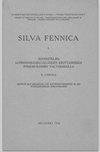桦树汁液渗出:林分中树木位置对桦树汁液生产、树干解剖和径向弯曲强度的影响
IF 1.7
3区 农林科学
Q2 FORESTRY
引用次数: 6
摘要
人们普遍认为,早春木质部汁液渗出的时期标志着树干内部正压力形成的阶段。当叶子出现时,这种状态发生了变化,开始了树干内的水分运输。然而,木材解剖结构及其机械阻力如何影响汁液尚不清楚。我们提出了罗斯树从林分内部和边缘渗出汁液与树干木材解剖结构及其弯曲强度之间关系的研究结果。在3月21日至4月18日期间,我们对林分边缘和林内树木的树液渗出量进行了5组测量。用断裂计测试了径向木材样品的弯曲强度。我们测试了树液的电导率和糖含量。对于木材的解剖分析,我们确定了每1mm血管的数量,平均血管管腔面积和潜在的电导率指数。我们发现沿着林分边缘的树木渗出更多的汁液,但其浓度低于来自林分内部的树木。垂直于木纤维的弯曲强度在林分边缘和树干西侧的树木中较高,其中每1平方毫米的容器数量和导电性指数较小。从表面上看,这是西风的结果,而西风在波兰占主导地位。桦木属pendula2本文章由计算机程序翻译,如有差异,请以英文原文为准。
Birch sap exudation: influence of tree position in a forest stand on birch sap production, trunk wood anatomy and radial bending strength
It is commonly accepted that the period of early-spring xylem sap exudation marks a stage during which a positive pressure builds inside the tree trunks. This state changes when leaves appear, initiating water transport within the trunk. It is unknown, however, how the wood anatomical structure and its mechanical resistance influences the sap. We present the results of research on the relationship between exudation of sap from Roth trees from the interior of a forest stand and from its edge, and the anatomical structure of the trunk wood and its bending strength. During the period between March 21 and April 18, we performed five sets of measurements of sap exudation from trees at the edge of the stand and from the forest interior. The resulting radial wood samples were tested for bending strength using a fractometer. We tested the sap for electrolytic conductivity and sugars content. For the anatomical analysis of the wood, we determined the number of vessels per 1 mm, average vessel lumen area and potential conductivity index. We found that the trees along the edge of the stand exude more sap, but it is less concentrated than the sap from the trees from the interior. Bending strength perpendicular to wood fibres is higher in the trees from the stand edge and in the western side of the trunk, where the number of vessels per 1 mm2 and conductivity index are smaller. Seemingly, this is the result of western winds, which are dominant in Poland.Betula pendula2
求助全文
通过发布文献求助,成功后即可免费获取论文全文。
去求助
来源期刊

Silva Fennica
农林科学-林学
CiteScore
3.50
自引率
11.10%
发文量
21
审稿时长
3 months
期刊介绍:
Silva Fennica publishes significant new knowledge on forest sciences. The scope covers research on forestry and forest ecosystems. Silva Fennica aims to increase understanding on forest ecosystems, and sustainable use and conservation of forest resources. Use of forest resources includes all aspects of forestry containing biomass-based and non-timber products, economic and social factors etc.
 求助内容:
求助内容: 应助结果提醒方式:
应助结果提醒方式:


